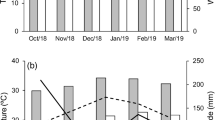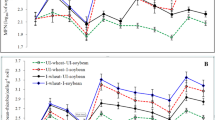Abstract
Foliar chlorosis of soybean (Glycine max [L.] Merr.) resulting from nodulation by rhizobitoxine-producing (RT+) strains of Bradyrhizobium japonicum is commonly less severe in the field than under greenhouse conditions. Differences in nutritional conditions between the field and greenhouse may contribute to this phenomenon. In particular, field-grown plants obtain some N from soil sources, whereas in the greenhouse soybean is often grown in low-N rooting media to emphasize symbiotic responses. Therefore, we examined the effect of NO3 - on the expression of RT-induced symptoms. Soybean plants inoculated with RT+ bradyrhizobia were grown for 42 days in horticultural vermiculite receiving nutrient solution amended with 0.0, 2.5, or 7.5 mM KNO3. Foliar chlorosis decreased with increasing NO3 - application whereas nodule mass per plant was generally increased by NO3 - application. Total amounts of nodular RT remained constant or increased with NO3 - application, but nodular concentrations of RT decreased. Chlorosis severity was negatively correlated with shoot dry weight, chlorophyll concentration, and total shoot N content. It was concluded that application of NO3 - can reduce the negative effects of RT production on the host plant. This suggests that any NO3 - present in field soils may serve to limit chlorosis development in soybeans.
Similar content being viewed by others
Abbreviations
- RT:
-
rhizobitoxine
- RT+ :
-
rhizobitoxine-producing
- Lb:
-
leghemoglobin
References
Ahmed S and Evans H J 1960 Cobalt: a micronutrient element for the growth of soybean plants under symbiotic conditions. Soil Sci. 90, 205–210.
Allos H F and Bartholomew W V 1959 Replacement of symbiotic nitrogen fixation by available nitrogen. Soil Sci. 87, 61–66.
Arnon D I 1949 Copper enzymes in isolated chloroplasts. Polyphenoloxidase in Beta vulgaris. Plant Physiol. 24, 1–15.
Becana M and Sprent J I 1989 Effect of nitrate on components of nodule leghaemoglobins. J. Exp. Bot. 40, 725–731.
Bergersen F J, Turner G L and Appleby C A 1973 Studies of the physiological role of leghaemoglobin in soybean root nodules. Biochim. Biophys. Acta 292, 271–282.
Bremnet J M 1965 Total nitrogen. In Methods of Soil Analysis, Part 2, Chemical and Microbiological Properties. Ed. C. A. Black. pp 1149–1178. American Society of Agronomy, Madison, Wisconsin.
Eaglesham A R J and Hassouna S 1982 Foliar chlorosis in legumes induced by cowpea Rhizobia. Plant and Soil 65, 425–428.
Eaton F M, Harding R B and Ganji T J 1960 Soil solution extractions at tenth-bar moisture percentages. Soil Sci. 90, 253–258.
Fuchsman W H and Appleby C A 1979 Separation and determination of the relative concentrations of the homogeneous components of soybean leghemoglobin by isoelectric focusing. Biochim. Biophys. Acta 597, 314–324.
Johnson H S and Hume D J 1973 Comparison of nitrogen fixation estimates in soybean by nodule weight, leghemoglobin content, and acetylene reduction. Can. J. Microbiol. 19, 1165–1168.
Johnson H W, Means U M and Clark F E 1958 Factors affecting the expression of bacterial-induced chlorosis of soybeans. Agron. J. 50, 571–574.
Kanayama Y and Yamamoto Y 1990 Inhibition of nitrogen fixation in soybean plants supplied with nitrate. II. Accumulation and properties of nitrosylleghemoglobin in nodules. Plant Cell Physiol. 31, 207–214.
Mahon J D and Child J J 1979 Growth response of inoculated peas (Pisum sativum) to combined nitrogen. Can. J. Bot. 57, 1687–1693.
McClure P R and Israel D W 1979 Transport of nitrogen in the xylem of soybean plants. Plant Physiol. 64, 411–416.
Minamisawa K and Kume N 1987 Determination of rhizobitoxine and dihydrorhizobitoxine in soybean plants by amino acid analyzer. Soil Sci. Plant Nutr. 33, 645–649.
Minamisawa K 1989 Comparison of extracellular polysaccharide composition, rhizobitoxine production, and hydrogenase phenotype among various strains of Bradyrhizobium japonicum. Plant Cell Physiol. 30, 877–884.
Noel K D, Carneol M and Brill W J 1982 Nodule protein synthesis and nitrogenase activity of soybeans exposed to fixed nitrogen. Plant Physiol. 70, 1236–1241.
Owens L D and Wright D A 1965 Rhizobial-induced chlorosis in soybeans: isolation, production in the nodule, and varietal specificity of the toxin. Plant Physiol. 40, 927–930.
Paau A S and Cowles J R 1979 Effect of induced nodule senescence on parameters related to dinitrogen fixation, bacteroid size and nucleic acid content. J. Gen. Microbiol. 111, 101–107.
Pate J S, Layzell D B and Atkins C A 1979 Economy of carbon and nitrogen in a nodulated and a non-nodulated (NO3-grown) legume. Plant Physiol. 64, 1083–1088.
Peterson G L 1977 A simplification of the protein assay method of Lowery et al, which is more generally applicable. Anal. Biochem. 83, 346–356.
Pfeiffer N E, Torres C M and Wagner F W 1983 Proteolytic activity in soybean root nodules. Plant Physiol. 71, 797–802.
Streeter J 1972 Nitrogen nutrition of field-grown soybean plants. I. Seasonal variations in soil nitrogen and nitrogen composition of stem exudate. Agron. J. 64, 311–314.
Streeter J 1982 Synthesis and accumulation of nitrite in soybean nodules supplied with nitrate. Plant Physiol. 69, 1429–1434.
Streeter J 1985 Nitrate inhibition of legume nodule growth and activity. I. Long-term study with a continuous supply of nitrate. Plant Physiol. 77, 321–324.
Teaney G B II and Fuhrmann J J 1992 Soybean response to nodulation by bradyrhizobia differing in rhizobitoxine production. Plant and Soil 145, 275–285.
Weaver R W and Frederick L R 1982 Rhizobium. In Methods of Soil Analysis. Part 2. Chemical and Microbiological Properties. 2nd edition. Eds. A L Page, D E Baker and R Ellis. pp 1043–1070. American Society of Agronomy, Soil Science Society of America, Madison, Wisconsin.
Weber D F 1987 Rhizobium-induced chlorosis and yield of soybeans. In Proc. Middle Atlantic Soybean Workers' Conf. p 10 (abstract). Beltsville, MD.
Yoneyama T, Karasuyama M, Kouchi H and Ishizuka J 1985 Occurrence of ureide accumulation in soybean plants; effect of nitrogen fertilization and N2 fixation. Soil Sci. Plant Nutr. 31, 133–140.
Author information
Authors and Affiliations
Additional information
Published as Miscellaneous Paper No. 1429 of the Delaware Agricultural Experiment Station.
Rights and permissions
About this article
Cite this article
Teaney, G.B., Fuhrmann, J.J. Soybean response to nodulation by rhizobitoxine-producing bradyrhizobia as influenced by nitrate application. Plant Soil 154, 219–225 (1993). https://doi.org/10.1007/BF00012527
Received:
Accepted:
Issue Date:
DOI: https://doi.org/10.1007/BF00012527




